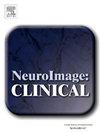Radiomics feature similarity: A novel approach for characterizing brain network changes in patients with behavioral variant frontotemporal dementia
IF 3.6
2区 医学
Q2 NEUROIMAGING
引用次数: 0
Abstract
Introduction
Network modeling is increasingly used to study brain alterations in neurological disorders. In this study, we apply a novel modeling approach based on the similarity of regional radiomics feature to characterize gray matter network changes in patients with behavioral variant frontotemporal dementia (bvFTD) using MRI data.
Methods
In this cross-sectional study, we assessed structural 3 T MRI data from twenty patients with bvFTD and 20 cognitively normal controls. Radiomics features were extracted from T1-weighted MRI based on cortical and subcortical brain segmentation. Similarity in radiomics features between brain regions was used to construct intra-individual structural gray matter networks. Regional mean connectivity strength (RMCS) and region-to-region radiomics similarity were compared between bvFTD patients and controls. Finally, associations between network measures, clinical data, and biological features were explored in bvFTD patients.
Results
Relative to controls, patients with bvFTD showed higher RMCS values in the superior frontal gyrus, right inferior temporal gyrus and right inferior parietal gyrus (FDR-corrected p < 0.05). Patients with bvFTD also showed several edges of increased radiomics similarity in key components of the frontal, temporal, parietal and thalamic pathways compared to controls (FDR-corrected p < 0.05). Network measures in frontotemporal circuits were associated with Mini-Mental State Examination scores and cerebrospinal fluid total-tau protein levels (Spearman r > |0.7|, p < 0.005).
Conclusions
Our study provides new insights into frontotemporal network changes associated with bvFTD, highlighting specific associations between network measures and clinical/biological features. Radiomics feature similarity analysis could represent a useful approach for characterizing brain changes in patients with frontotemporal dementia.
放射组学特征相似性:一种表征行为变异额颞叶痴呆患者脑网络变化的新方法
网络建模越来越多地用于研究神经系统疾病的大脑变化。在这项研究中,我们采用一种基于区域放射组学特征相似性的新型建模方法,利用MRI数据表征行为变异性额颞叶痴呆(bvFTD)患者的灰质网络变化。方法在本横断面研究中,我们评估了20例bvFTD患者和20例认知正常对照的结构3t MRI数据。基于大脑皮层和皮层下分割,从t1加权MRI中提取放射组学特征。脑区域间放射组学特征的相似性被用于构建个体内部结构灰质网络。比较bvFTD患者和对照组之间的区域平均连接强度(RMCS)和区域间放射组学相似性。最后,探讨了bvFTD患者的网络测量、临床数据和生物学特征之间的关系。结果与对照组相比,bvFTD患者在额上回、右侧颞下回和右侧顶叶下回(fdr校正p <;0.05)。与对照组相比,bvFTD患者在额叶、颞叶、顶叶和丘脑通路的关键组成部分也显示出增加的放射组学相似性(fdr校正p <;0.05)。额颞叶回路的网络测量与迷你精神状态检查分数和脑脊液总tau蛋白水平相关(Spearman r > |0.7|, p <;0.005)。结论我们的研究提供了与bvFTD相关的额颞叶网络变化的新见解,突出了网络测量与临床/生物学特征之间的特定关联。放射组学特征相似性分析可能是表征额颞叶痴呆患者大脑变化的有用方法。
本文章由计算机程序翻译,如有差异,请以英文原文为准。
求助全文
约1分钟内获得全文
求助全文
来源期刊

Neuroimage-Clinical
NEUROIMAGING-
CiteScore
7.50
自引率
4.80%
发文量
368
审稿时长
52 days
期刊介绍:
NeuroImage: Clinical, a journal of diseases, disorders and syndromes involving the Nervous System, provides a vehicle for communicating important advances in the study of abnormal structure-function relationships of the human nervous system based on imaging.
The focus of NeuroImage: Clinical is on defining changes to the brain associated with primary neurologic and psychiatric diseases and disorders of the nervous system as well as behavioral syndromes and developmental conditions. The main criterion for judging papers is the extent of scientific advancement in the understanding of the pathophysiologic mechanisms of diseases and disorders, in identification of functional models that link clinical signs and symptoms with brain function and in the creation of image based tools applicable to a broad range of clinical needs including diagnosis, monitoring and tracking of illness, predicting therapeutic response and development of new treatments. Papers dealing with structure and function in animal models will also be considered if they reveal mechanisms that can be readily translated to human conditions.
 求助内容:
求助内容: 应助结果提醒方式:
应助结果提醒方式:


